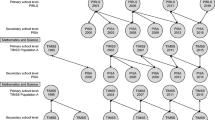Abstract
Aggregated group-level effects (AGLEs) are widely considered to be an extremelyimportant aspect of learning. However some authors have implied that many apparentfindings of such effects are spurious and arise because of omission or inadequatemeasurement of pre-existing differences. This study considers a further trap, inwhich the appropriate variables are included, but are measured with error.
It shows allowing for measurement error does in fact impact on apparent AGLEs,and that the effects of allowing for measurement error, while apparently inconsistent,can largely be explained as increasing the apparent effect of a variable, and decreasingthe apparent effects of other correlated variables.
Similar content being viewed by others
References
Aitkin, M. & Longford, N. (1986). Statistical modelling in school effectiveness studies. Journal of the Royal Statistical Society A 149: 1–43.
Alexander, K. L. & Eckland, B. K. (1975). Contextual effects in the high school attainment process,American Sociological Review 43: 3–22.
Alwin, D. F. & Otto, L. B. (1977). High School Context Effects on Aspirations', Sociology of Education 49(50): 259–273.
Bondi, L. (1991). 'Attainment in Primary Schools', British Educational Research Journal 17: 203–217.
Fuller, W. A. (1987). Measurement Error Models.London and New York: Wiley.
Gray, J, Jesson, D. & Sime, N. (1990). Estimating differences in the examination performance of secondary schools in six LEAs: a multilevel approach to school effectiveness, Oxford Review of Education 16(2): 137–158.
Hagley, F. (1987). Suffolk Reading Scale: Teacher's Guide.Windsor: NFER-Nelson.
Harlen, W. & Malcolm, H. (1997). Setting and Streaming: A Research Review.Edinburgh: SCRE.
Hauser, R. M., Sewell, W. H. & Alwin, D. (1976). 'High School Effects on Achievement', in W. H. Sewell, R. M. Hauser and D. L. Featherman, Schooling and Achievement in American Society.New York: Academic Press.
Henderson, V., Mieszkowski, P. & Sauvageau, Y (1978). 'Peer Group Effects and Educational Production Functions', Jr. Public Economics 10: 97–106.
Hutchison, D. (1993). 'School Effectiveness Studies Using Administrative Data', Educational Research 35: 27–47.
Hutchison, D. (1998). 'The Effect of Group-Level Influences on Pupils' Progress in Reading. Statistic Working Paper 1/98 Slough: National Foundation for Educational Research.
Hutchison, D. (1999). 'The Effect of Group-Level Influences on Pupils' Progress in Reading', Ph.D. Thesis, University of London.
Mortimore, P., Sammons, P., Stoll, L., Lewis, D. & Ecob, R. (1988). School Matters, London: Open Books.
Peaker, G. (1967). 'Statistical Appendix' in Children and Their Primary Schools, The Plowden Report.
Rutter, M., Maughan, B., Mortimore, P. & Ouston, J. (1979). Fifteen Thousand Hours: Secondary Schools and their Effects on Children.London: Open Books.
Smith, D. & Tomlinson, S. (1989). The School Effect: A Study of Multi-Racial Comprehensives. London: Policy Studies Institute.
Snijders, T. A. & Bosker, R. (1999). Multilevel Analysis: An Introduction to Basic and Advanced Multilevel Modelling.London, Thousand Oaks, New Delhi: Sage Publications.
Sukhnandan, L. & Lee, B. (1998), Streaming, Setting and Grouping by Ability: A Review of the Literature .Slough: National Foundation for Educational Research.
Summers, A. & Wolfe, B. (1974), Equality of Educational Opportunity Quantified: A Production Function Approach.Philadelphia: Federal Reserve Bank of Philadelphia.
Thomas, S. & Mortimore, P. (1996). 'Comparison of Value-Added Models for Secondary School Effectiveness', Research Papers in Education 11(1): 5–33.
Willms (1985). 'The Balance Thesis: Contextual Effects of Ability on Pupils' O-grade Examination Results', Oxford Review of Education11: 33–41.
Willms (1986). Social Class Segregation and Its Relationship to Pupils' Examination Results in Scotland', American Sociological Review 51: 224–241.
Woodhouse, G., Yang, M., Goldstein, H., Rasbash, J. & Pan, H. (1996). 'Adjusting for Measurement Error in Multilevel Analysis', Jr. Roy. Statist. Soc. (A) 159(2), 201–212.
Rights and permissions
About this article
Cite this article
Hutchison, D. The Effect of Measurement Errors on Apparent Group Level Effects in Educational Progress. Quality & Quantity 38, 407–424 (2004). https://doi.org/10.1023/B:QUQU.0000043116.22582.fd
Issue Date:
DOI: https://doi.org/10.1023/B:QUQU.0000043116.22582.fd




